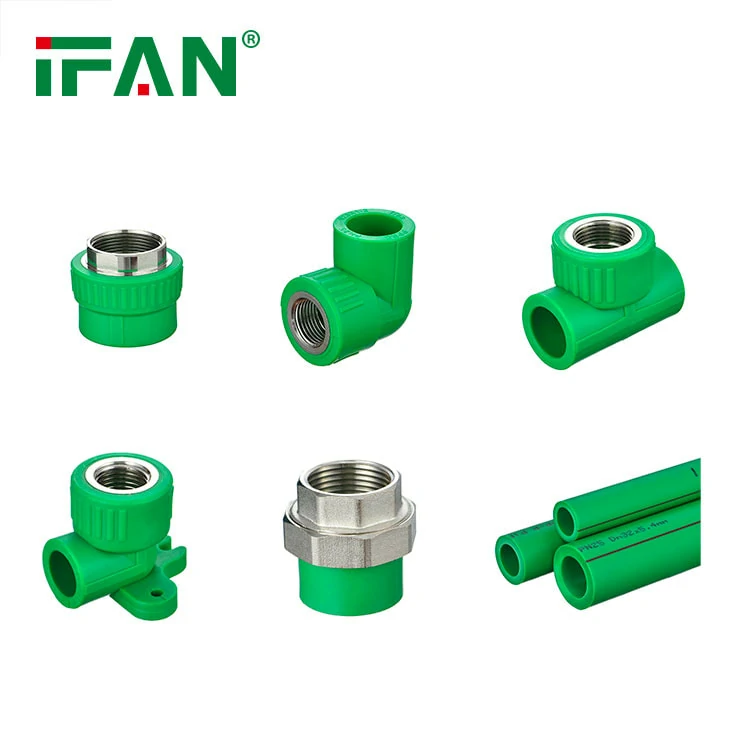Introduction
In the ever-evolving landscape of plumbing, the choice between PPR (Polypropylene Random Copolymer) fittings and traditional metal pipe fittings is a decision that significantly influences the performance and durability of plumbing systems. This article conducts a thorough comparative analysis, shedding light on the advantages and disadvantages of PPR fittings in contrast to their traditional metal counterparts.

1. The Modern Marvel: PPR Fittings in Focus
Chemical Resistance and Corrosion Immunity:
- Chemical Stability: Dive into the chemical stability of PPR fittings, emphasizing their resistance to corrosion. Unlike metal fittings, PPR fittings are immune to rust and degradation, ensuring a longer lifespan and consistent performance.
- Non-Toxic Composition: Highlight the non-toxic nature of PPR fittings, making them ideal for conveying potable water without introducing harmful substances. This characteristic is crucial for applications where water quality is of utmost importance.
Ease of Installation and Lightweight Design:
- Effortless Installation: Discuss the ease of installation offered by PPR fittings due to their lightweight design. The simplicity of installation translates to reduced labor costs and quicker project completion, making PPR a preferred choice in modern construction projects.
- Adaptability in Complex Structures: Explore how the flexibility of PPR fittings allows for easy adaptation to complex structures. Unlike rigid metal fittings, PPR fittings provide versatility in plumbing applications for both residential and commercial settings.
Thermal Performance and Energy Efficiency:
- Thermal Insulation: Highlight the thermal insulation properties of PPR fittings, contributing to energy efficiency in applications like hot water supply. PPR’s insulation capabilities prevent heat loss or gain, ensuring optimal performance in various temperature conditions.
- Reduced Condensation Risks: Discuss how the inherent thermal properties of PPR fittings minimize the risk of condensation. This feature not only maintains the integrity of the plumbing system but also contributes to a more controlled and dry environment.
2. The Time-Tested Tradition: Traditional Metal Pipe Fittings under the Spotlight
Strength and Durability:
- High Mechanical Strength: Acknowledge the high mechanical strength of metal pipe fittings, suitable for applications demanding robustness. In scenarios where strength is paramount, metal fittings showcase their endurance.
- Susceptibility to Corrosion: Discuss the downside of traditional metal fittings – their susceptibility to corrosion. The regular maintenance and potential need for replacements make metal fittings less favorable in corrosive environments.
Weight and Maneuverability:
- Heaviness of Metal Fittings: Address the considerable weight of metal pipe fittings, which can complicate handling and installation processes. This characteristic may result in increased labor costs and longer installation times compared to the lightweight nature of PPR fittings.
- Limitations in Complex Installations: Explore how the rigidity of metal fittings may pose challenges in adapting to intricate or complex plumbing structures. PPR’s adaptability proves advantageous in modern construction projects where flexibility is key.
Thermal Conductivity and Energy Loss:
- High Thermal Conductivity: Discuss the higher thermal conductivity of metal fittings, leading to potential energy loss in heating or cooling applications. This characteristic can be a drawback in projects where energy efficiency is a priority.
- Condensation Risks: Highlight the increased risk of condensation due to thermal conductivity in metal fittings. This risk can result in issues such as pipe sweating and water damage, underscoring the importance of insulation in certain applications.
3. Decision Time: Weighing the Pros and Cons
Environmental Impact and Sustainability:
- PPR’s Eco-Friendly Profile: Emphasize the eco-friendly nature of PPR fittings, as they are recyclable and contribute to sustainable plumbing practices. This contrasts with the environmental impact of traditional metal fittings, which may require more resources for production and disposal.
- End-of-Life Considerations: Discuss responsible end-of-life considerations, where PPR fittings may have a smaller ecological footprint compared to traditional metal fittings. Proper disposal practices and recycling initiatives contribute to the sustainability of plumbing materials.
Cost-Effectiveness and Long-Term Investment:
- Initial Costs vs. Long-Term Savings: Address the initial costs of PPR fittings compared to traditional metal fittings. While PPR may have lower upfront costs, emphasize the potential long-term savings due to reduced maintenance, energy efficiency, and extended lifespan.
- Evaluating Return on Investment: Encourage stakeholders to evaluate the return on investment by considering factors like maintenance, energy savings, and the overall longevity of the plumbing system. This holistic approach ensures a comprehensive understanding of the cost-effectiveness of each option.
Conclusion
In conclusion, the decision between PPR fittings and traditional metal pipe fittings involves a careful consideration of specific project requirements and priorities. While metal fittings offer strength and durability, PPR fittings provide advantages in terms of chemical resistance, ease of installation, and thermal performance. Understanding the distinct characteristics and potential drawbacks of each option allows stakeholders to make informed decisions based on the unique demands of their plumbing projects. Whether embracing the modern versatility of PPR or relying on the time-tested tradition of metal, the key lies in aligning the chosen fittings with the specific needs and goals of the plumbing system at hand.
Contact
IFAN is a Chinese manufacturer of plastic pipes, fittings and valves with 30 years of experience. If you are interested in IFAN’s PPR, valves, pipes and fittings, please contact us. IFAN offers you a variety of standard pipes to meet your specific needs. Click below to learn more about IFAN’s wide range of high-quality, cost-effective plastic pipe fittings.
We will reply your email or fax within 24 hours.
You can call us at any time if there is any question on our production.
For more information,pls visit our webside https://www.ifanplus.com/
Pls Mailto: [email protected]






